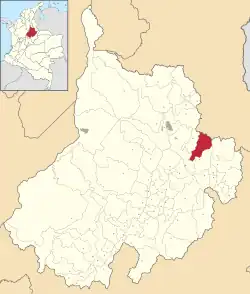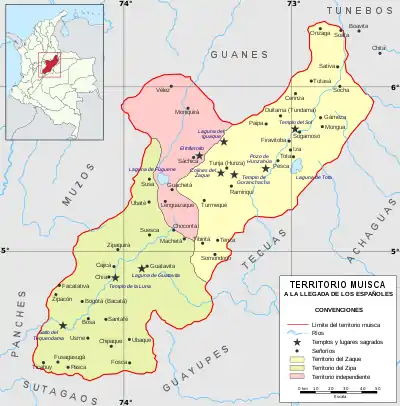Lache people
The Lache were an indigenous, agrarian people in the highlands of what is now central Colombia's northern Boyacá and Santander departments, primarily in Gutiérrez Province and García Rovira Province.[1][2] They were part of the Cocuy Confederation[3] and spoke Chibcha, trading predominantly with other Chibcha speakers, such as the Muisca, Guane, Pijao and Chitarero.[4] Trade included salt and textiles, as well as food stuffs.[4][5] The Lache farmed maize, potatoes, quinoa and cotton, among other crops.[6]
 Topography of Santander Department The Lache lived in highlands of the eastern part, continuing into Boyacá | |
| Total population | |
|---|---|
| 0 (2004) | |
| Regions with significant populations | |
| Santander, Boyacá, | |
| Languages | |
| Chibcha | |
| Religion | |
| Traditional | |
| Related ethnic groups | |
| U'wa, Muisca, Guane |
In the 17th century, Lucas Fernández de Piedrahita wrote of the habit of the Laches in bringing up younger male children as culturally female.[7][8]
The name Lache is preserved in a barrio of Bogotá known as Los Laches.
Municipalities belonging to Lache territory
The Lache inhabited the highlands of eastern Santander and northern Boyacá and a small part of northwesternmost Casanare.[1][9][10]
| Name | Department | Altitude (m) urban centre |
Map |
|---|---|---|---|
| Capitanejo | Santander | 1090 |  |
| Carcasí | Santander | 2080 |  |
| Cepitá | Santander | 3000 |  |
| Cerrito | Santander | 2220-4200 |  |
| Concepción | Santander | 2005 |  |
| Enciso | Santander | 1484 |  |
| Guaca | Santander | 2401 |  |
| Macaravita | Santander | 2320 |  |
| Málaga | Santander | 2235 |  |
| Molagavita | Santander | 2196 |  |
| San Andrés | Santander | 1617 |  |
| San José de Miranda | Santander | 2381 |  |
| San Miguel | Santander | 2200 |  |
| Chiscas | Boyacá | 2368 |  |
| Chita | Boyacá | 2964 |  |
| El Cocuy | Boyacá | 2750 |  |
| El Espino | Boyacá | 2128 |  |
| Guacamayas | Boyacá | 2296 |  |
| Jericó (shared with Muisca) |
Boyacá | 3100 |  |
| Panqueba | Boyacá | 2258 |  |
| La Salina | Casanare | 1400 |  |
| San Mateo | Boyacá | 2500 |  |
| La Uvita | Boyacá | 2700 |  |
See also
References
- (in Spanish) Los Laches y Chitareros y sus caminos a la llegada de los españoles
- Rodríguez 1992, p. 17
- Rueda, Carl Henrik Langebaek (1987). "Tres formas de acceso a recursos en territorio de la confederación del Cocuy, siglo XVI". Boletín Museo del Oro (in Spanish). 18: 29–45.
- Rodríguez 1992, p. 18
- Acuña Rodríguez, Blanca Ofelia (2006). "Territorio indígena de la sal en la Sierra Nevada del Cocuy. S. XVI" (PDF). Historia y Espacio (in Spanish) (27).
- Rodríguez 1996
- Trexler 1999, p. 86
- Tribín, Hugo Armando Sotomayor (June 2003). "Una reflexión histórico - antropológica sobre el maltrato infantil en Colombia (Segunda Parte)". Pediatria (in Spanish). 38 (2). Archived from the original on 5 April 2009.
- (in Spanish) Lache people territories
- (in Spanish) Indigenous groups of Boyacá and surroundings Archived 2011-12-25 at the Wayback Machine - Banco de la República
Bibliography
- Rodríguez, José Vicente (1992). "Características Físicas de la Población Prehispánica de la Cordillera Oriental de Colombia: Implicaciones Etnogenéticas". Maguaré. 8: 7–45.
- Rodríguez, José Vicente (1996). Dieta, Salud y Demografía Prehispánica en la Cordillera Oriental de Colombia: Mitos y Realidades Sobre el Bienestar Aborigen. Departamento de Antropología, Facultad Ciencias Humanas, Universidad Nacional de Colombia, Santafé de Bogotá.
- Trexler, Richard C. (1999). Sex and Conquest: Gendered Violence, Political Order, and the European Conquest of the Americas. Cornell University. pp. 1–304. ISBN 9780801484827. Retrieved 2016-07-08.
Further reading
- Ariza, Gonzalo (1952). Los Laches. Villegas Editores.
External links
- "La Coctelera: Realidades Colombianas - Historia y Geografía: Asi es Santander 3" (in Spanish). 21 June 2003. Archived from the original on 30 December 2005. Retrieved 5 August 2006.
